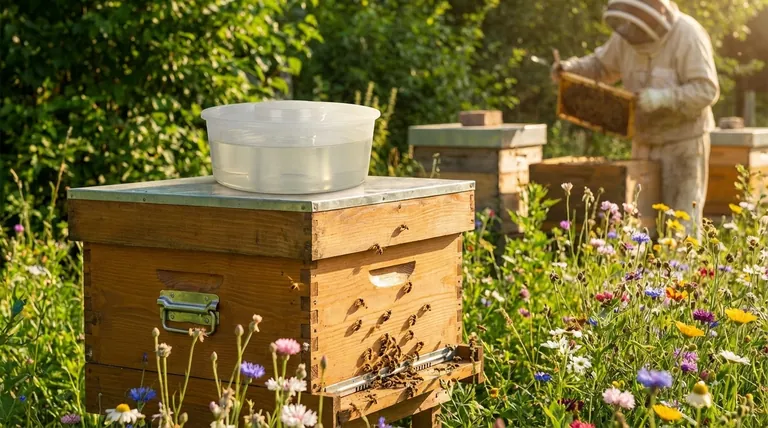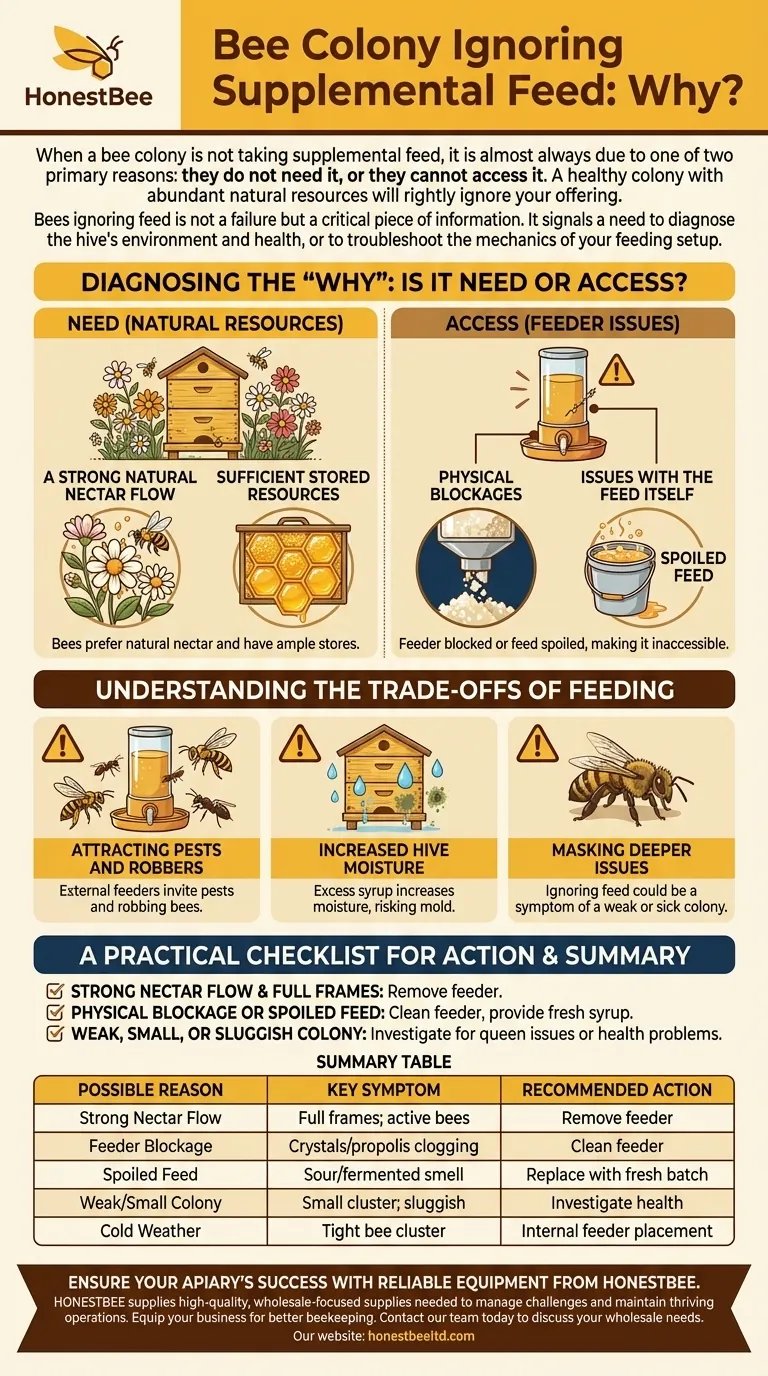When a bee colony is not taking supplemental feed, it is almost always due to one of two primary reasons: they do not need it, or they cannot access it. Your first step is not to worry, but to investigate which of these scenarios is true for your hive. A healthy colony with abundant natural resources will rightly ignore your offering.
Bees ignoring feed is not a failure but a critical piece of information. It signals a need to diagnose the hive's environment and health, or to troubleshoot the mechanics of your feeding setup.

Diagnosing the "Why": Is It Need or Access?
Before assuming a problem with the colony, you must first understand why they might be refusing the feed. The answer will guide your next steps and provides valuable insight into the state of your hive and its surrounding environment.
A Strong Natural Nectar Flow
The most common and best-case scenario is that your bees have found a better food source. Bees will almost always prefer natural flower nectar over sugar syrup. If there is a strong nectar flow in your area, they will completely ignore even the most accessible feeders.
Sufficient Stored Resources
Open your hive and perform a quick inspection. If the frames are heavy and filled with glistening nectar or capped honey, the colony has all the resources it needs at the moment. They have no incentive to take additional liquid feed.
Colony Size and Temperature
A very small colony, like a new nucleus hive, will consume feed much more slowly than a large, established one. Furthermore, if temperatures are too cold, the bee cluster will be too tight to break away and access the feeder, especially if it is located far from them.
Investigating Your Feeder and Feed
If you've ruled out a strong nectar flow and the hive has room for more stores, the problem likely lies with your equipment or the feed itself. A feeder that is inaccessible is no feeder at all.
Physical Blockages
This is a frequent and easily solved problem. Check your feeder's access points for sugar crystals that have hardened and blocked the holes. For contact feeders (like bucket or jar feeders), also inspect the lid for propolis, a sticky resin bees use to seal gaps. A hot wash can easily clear these blockages.
Issues with the Feed Itself
The syrup you provide can become a problem. If the feed has been in the hive for a long time, especially in warm weather, it can begin to ferment. Bees will refuse spoiled or sour feed. Additionally, a syrup mix that is too thick or too thin for the season might be less appealing.
Feeder Placement
Bees may not find or be able to reach the feeder. An entrance feeder on a very large hive might be too far from the main cluster. A top feeder in cold weather may be too far for the bees to travel. Ensure the feeder is positioned where the bees will easily encounter it.
Understanding the Trade-offs of Feeding
Leaving a feeder on a hive that doesn't need it is not a neutral act. It can introduce new risks and mask important information about your colony's health.
Attracting Pests and Robbers
An external feeder or any spilled syrup is an open invitation to ants, wasps, and—most dangerously—robbing bees from other colonies. A robbing frenzy can quickly decimate a weaker hive.
Increased Hive Moisture
Large volumes of sugar syrup introduce significant moisture into the hive. The bees must work to dehydrate it, which can be a challenge during cold or humid periods and can contribute to mold.
Masking Deeper Issues
Assuming a strong colony is simply ignoring feed could cause you to miss a critical problem. If the colony is actually weak, dwindling, or sick, its lack of interest in feed is a symptom of a much more serious issue that requires immediate intervention.
A Practical Checklist for Action
Use your observations to determine the correct course of action. Your response should be tailored to what the bees are telling you.
- If your inspection reveals a strong nectar flow and full frames: Remove the feeder entirely, as your job is done and the bees are self-sufficient.
- If you find a physical blockage or spoiled feed: Clean the feeder thoroughly, provide a fresh batch of syrup, and monitor to see if they begin taking it.
- If the colony appears weak, small, or sluggish and still isn't feeding: Investigate for underlying health issues such as queen problems or high mite loads, as the lack of feeding is a symptom.
Trusting your bees' behavior is the first step toward becoming a more observant and effective beekeeper.
Summary Table:
| Possible Reason | Key Symptom | Recommended Action |
|---|---|---|
| Strong Nectar Flow | Full frames of nectar/honey; bees active. | Remove feeder; bees are self-sufficient. |
| Feeder Blockage | Crystals/propolis clogging access points. | Clean feeder thoroughly; provide fresh syrup. |
| Spoiled Feed | Syrup smells sour or fermented. | Replace with a fresh, properly mixed batch. |
| Weak/Small Colony | Small cluster; sluggish bees; low population. | Investigate for queen issues, disease, or mites. |
| Cold Weather | Tight bee cluster; feeder is far from cluster. | Consider internal or closer feeder placement. |
Ensure your apiary's success with reliable equipment from HONESTBEE.
A colony's refusal to feed is a critical signal. Proper diagnosis requires dependable tools, from durable feeders for effective supplementation to essential gear for hive health inspections. HONESTBEE supplies commercial apiaries and beekeeping equipment distributors with the high-quality, wholesale-focused supplies needed to manage these challenges effectively and maintain thriving operations.
Equip your business for better beekeeping. Contact our team today to discuss your wholesale needs.
Visual Guide

Related Products
- Rapid Bee Feeder White Plastic 2L Round Top Feeder for 8 or 10-Frame Bee Hives
- HONESTBEE Round Hive Top Bee Feeder for Syrup
- Professional Hive Front Entrance Bee Feeder
- Classic Boardman Entrance Bee Feeder Hive Front Feeding Solution
- HONESTBEE Entrance Bee Feeder Professional Hive Nutrition Solution for Beekeeping
People Also Ask
- What is the capacity of the round hive top feeder for syrup and pollen? A Guide to Targeted Apiary Support
- What is the advice regarding feeding bees to limit brood production based on? Managing Prolific Bee Strains
- How much honey does a strong hive need to survive winter? Ensure Your Colony's Survival (60-80 lbs)
- What can the round hive top feeder be used for? A Guide to Efficient, Safe Bee Feeding
- Can you dilute honey and feed it to the bees? Understand the Critical Risks and Safe Practices



















